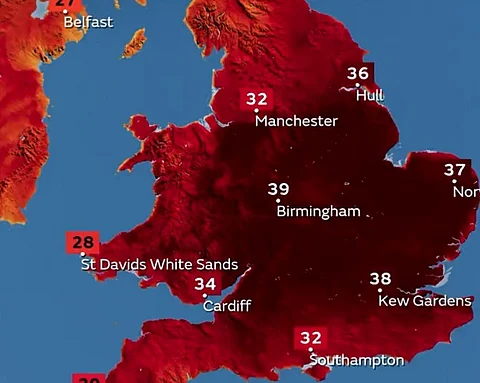

Britain recorded its first-ever temperature exceeding 40 degrees Celsius, as predicted by the UK Met Office. The mercury registered 40.2°C at London's Heathrow Airport, July 19,2022.
“If you ever can feel the direct impacts of human-induced climate change, it's now,” Mika Rantanen, researcher in weather and climate change impact research unit, Finnish Meteorological Institute, wrote on Twitter.
Climate change could increase the frequency of such extreme temperatures if no action is taken to control greenhouse gas emissions, experts warned.
Of the top five warmest days reliably recorded in the UK, since the 19th century, four have occurred in just the last four years (including Tuesday’s anticipated temperatures),” Simon H Lee, Postdoctoral research scientist in the department of applied physics and applied mathematics at Columbia University, told Down To Earth.
The UK is not used to such high temperatures. “So, while in India and many parts of the world, these temperatures will be annually quite normal, we haven't got the infrastructure in this country to deal with such high temperatures” Matthew Blackett, reader (associate professor), Coventry University, told DTE.
The Met Office issued a ‘red warning’ for central, northern, eastern and southeastern England from July 18 to July 19, 2022.
On July 18, temperatures in parts of the county crossed 30 °C, with Hawarden, a village in Wales, recording a high of 37.1°C. With that, the region broke its previous record of 35.2°C, set in the same place in 1990, according to the Met Office.
Meanwhile, Gogerddanin in Wales reached 35.3°C and Stanton Downham in eastern England recorded 38. 1°C. It was 31.3 °C in Aboyne in Scotland and 31.1°C in Derrylin in Northern Ireland, data showed.
The average mean temperature in July between 1991-2020 was roughly 15.2°C, data suggested.
July 19 is unlikely to offer any respite. The Met Office predicted that much of England, Wales and parts of Scotland are expected to see a scorching day.
Heat can intensify in southeast Scotland. Experts have issued a ‘red warning’ alert to large parts of Central and Northern England, according to meteorologists.
Some spots in these regions are likely to beat the previous high of 38.7°C, recorded July 25, 2019, at Cambridge Botanic Garden. London is expected to touch 40°C July 19, 2022, the Met Office announced.
The warming is being driven by climate change, experts said. A 2020 study, found that temperatures above 35 °C have become increasingly common in the southeast UK.
“The chances of seeing 40°C days in the country could be as much as ten times more likely in the current climate than under a natural climate unaffected by human influence,” Nikos Christidis, climate attribution scientist at the Met Office, said in a statement.
He further added that the likelihood of exceeding 40°C anywhere in the UK is also rapidly increasing.
“Even with current pledges on emission reductions, such extremes could be taking place every 15 years in the climate of 2100,” he warned.
Another driver is the plume of exceptionally hot air moving up from Africa via Iberia and France, Lee said.
“The dry soils are also exaggerating the temperatures in these regions,” he explained, adding that dry ground heats up faster than wet ground as energy is not lost to evaporation.
A hot-pressure system is prevailing over Europe for a few days, Blackett pointed out. These systems move in a clockwise direction, sucking up a lot of the hot air into the UK from the Sahara Desert and North Africa, he added.
In high-pressure systems, the air falls to the ground. As this happens, cloud formation becomes scarce. This is because clouds need rising air to form, according to the American Geosciences Institute.
Without clouds, there's no shelter from the intense sun, Blackett explained.
Night-time temperatures are shooting up this season. “At higher temperatures, the atmosphere can hold more water vapour and water vapour itself is a greenhouse gas,” Lee explained.
Human-made tarmac bricks and building materials are contributing to this. They absorb heat throughout the day and emit it at night, Blackett added.
The extreme heat could take a toll on the people as the country lacks the infrastructure to tackle it, said Blackett.
Apartments, for instance, in the UK, have been built with good insulation, preventing heat dissipation, he said. “That's probably the same with most British homes they built, thinking that we're a cold country,” he added.
The expert calls for increasing the green cover and setting up green roofs to manage heat. “If the government does not prioritise building climate resilient homes, the market should,” he said.
There is also a need for a cultural change, he added. “People here love the sun. They need to be told that exposure to such heat could cause heat stress and stroke,” he stressed.